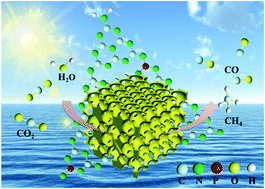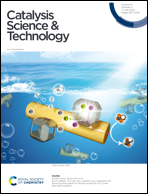Phosphorus-doped inverse opal g-C3N4 for efficient and selective CO generation from photocatalytic reduction of CO2†
Abstract
In this work, inverse opal (IO) structure construction and phosphorus doping were combined to modify carbon nitride (g-C3N4) for the photocatalytic reduction of CO2. The inverse opal structure was fabricated by a hard template method, and the phosphorus doping was introduced by heat treatment of the mixed inverse opal g-C3N4 and NaH2PO2. The inverse opal structure greatly improved the specific surface area and enhanced the light absorption of g-C3N4, and the phosphorus doping can significantly change the electronic properties and surface charges, narrow the band gap and suppress the recombination of photogenerated charge carriers. The obtained catalyst P–IO CN exhibited excellent photocatalytic activity for CO2 reduction. Experimental results reveal that the products of all samples were CO and CH4. CO was detected as the main product with selectivity reaching 91% and the CO evolution rate of P–IO CN reached 31.22 μmol g−1 h−1, which is about 3.3 and 6 times higher than that of IO CN and bulk CN, respectively. Our work provides new insight into the enhanced photocatalytic reduction of CO2 with metal-free materials in the era of energy shortage.



 Please wait while we load your content...
Please wait while we load your content...